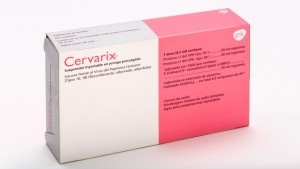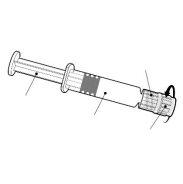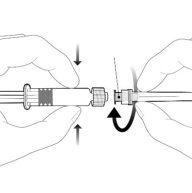

CERVARIX SUSPENSION FOR INJECTION IN PRE-FILLED SYRINGE


How to use CERVARIX SUSPENSION FOR INJECTION IN PRE-FILLED SYRINGE
Introduction
Package Leaflet:Information for the User
Cervarix suspension for injection in pre-filled syringe
Vaccine against Human Papillomavirus [Types 16, 18]
(Recombinant, adjuvanted, adsorbed)
Read all of this leaflet carefully before you start receiving this vaccine,because it contains important information for you.
- Keep this leaflet, you may need to read it again.
- If you have any further questions, ask your doctor or pharmacist.
- This medicine has been prescribed for you only, and you should not pass it on to others.
- If you experience any side effects, talk to your doctor or pharmacist, even if they are not listed in this leaflet. See section 4.
Contents of the package leaflet:
- What is Cervarix and what is it used for
- What you need to know before you receive Cervarix
- How to administer Cervarix
- Possible side effects
- Storage of Cervarix
- Package contents and further information
1. What is Cervarix and what is it used for
Cervarix is a vaccine that is indicated to protect individuals from the age of 9 years against diseases caused by Human Papillomavirus (HPV) infection.
These diseases include:
- cervical cancer (i.e. cancer of the neck of the womb or uterus) and anal cancer,
- pre-cancerous lesions of the cervix, vulva, vagina, and anus (changes in the genital or anal cells that have a risk of turning into cancer).
The types of Human Papillomavirus (HPV) contained in the vaccine (types 16 and 18) are responsible for approximately 70% of cervical cancers, 90% of anal cancers, 70% of vulvar and vaginal pre-cancerous lesions related to HPV, and 78% of anal pre-cancerous lesions related to HPV. Other types of HPV can also cause anogenital cancers. Cervarix does not protect against all types of HPV.
When a person is vaccinated with Cervarix, the immune system (the body's natural defense system) generates antibodies against HPV types 16 and 18.
Cervarix is not infectious and therefore cannot cause HPV-related diseases.
Cervarix is not used to treat HPV-related diseases that are already present at the time of vaccination.
Cervarix should be used in accordance with official recommendations.
2. What you need to know before you start receiving Cervarix
Cervarix must not be administered
- if you are allergic to any of the active substances or to any of the other components of this vaccine (listed in section 6). The signs of an allergic reaction may include skin rash with itching, difficulty breathing, and swelling of the face or tongue.
Warnings and precautions
Talk to your doctor or pharmacist before receiving Cervarix:
- if you have a bleeding problem or bruise easily
- if you have any disease that reduces your resistance to infection, such as an HIV infection
- if you have a severe infection with high fever. It may be necessary to postpone vaccination until you recover. A minor infection, such as a cold, should not be a problem for vaccination, but before being vaccinated, discuss it with your doctor.
Before or after any injection, fainting (especially in adolescents) may occur, so you should inform your doctor or nurse if you or your child have fainted after receiving an injection in the past.
Like all vaccines, Cervarix may not fully protect all people who are vaccinated.
Cervarix does not protect against diseases caused by HPV infection if, at the time of vaccination, the subjects are already infected with HPV types 16 or 18.
Although vaccination may protect you against cervical cancer, it is not a substitute for regular cervical screening. You should follow your doctor's advice regarding cervical smear tests/Pap tests (a test to detect changes in the cells of the cervix caused by an HPV infection) and the use of protective measures.
As Cervarix does not protect against all types of Human Papillomavirus, you should continue to take appropriate precautions to avoid contracting HPV and other sexually transmitted diseases.
Cervarix does not protect against other diseases that are not caused by Human Papillomavirus.
Other medicines and Cervarix
Cervarix can be administered with a combined booster vaccine that contains diphtheria (d), tetanus (T), and pertussis [acellular] (pa), with or without inactivated poliomyelitis (IPV) (dTpa, dTpa-IPV vaccines), with a combined hepatitis A and hepatitis B vaccine (Twinrix), with a hepatitis B vaccine (Engerix B), or with a conjugate vaccine with tetanus toxoid against meningococcal serogroups A, C, W-135, and Y (MenACWY-TT), at a different injection site (another part of your body, for example, the other arm) during the same visit.
Cervarix may not have an optimal effect if you are using medicines that suppress the immune system.
In clinical trials, the use of oral contraceptives (e.g. the pill) did not reduce the protection obtained by Cervarix.
Tell your doctor if you are using, have recently used, or might use any other medicine or if you have recently received any other vaccine.
Pregnancy, breastfeeding, and fertility
If you are pregnant, have become pregnant during the vaccination period, or are planning to become pregnant, it is recommended that you postpone or interrupt vaccination until the end of pregnancy.
If you are pregnant or breastfeeding, think you may be pregnant, or plan to become pregnant, consult your doctor before receiving this vaccine.
Driving and using machines
Cervarix is unlikely to affect your ability to drive or use machines. However, do not drive or use machines if you do not feel well.
Cervarix contains sodium
This vaccine contains less than 1 mmol of sodium (23 mg) per dose; this is essentially "sodium-free".
3. How to administer Cervarix
How the vaccine is administered
Your doctor or nurse will administer Cervarix by injection into the muscle of the upper arm.
How much to administer
Cervarix is indicated for individuals from the age of 9 years.
The total number of injections you will receive will depend on your age at the time of the first injection.
If you are between 9 and 14 years old
You will receive 2 injections:
First injection: on the chosen date.
Second injection: between 5 and 13 months after the first injection.
If you are 15 years old or more
You will receive 3 injections:
First injection: on the chosen date.
Second injection: 1 month after the first injection.
Third injection: 6 months after the first injection.
In case of need, the vaccination schedule can be more flexible. Consult your doctor for more information.
Once the first dose of Cervarix has been administered, it is recommended that Cervarix (and not another HPV vaccine) be used to complete the vaccination schedule.
Cervarix is not recommended for use in individuals under 9 years of age.
The vaccine should never be injected into a vein.
If you miss a dose
It is important that you follow the instructions given by your doctor or nurse regarding follow-up visits. If you miss your doctor's appointment, ask your doctor for advice.
If you do not complete the full vaccination cycle (two or three injections, depending on your age at the time of vaccination), you may not obtain the best effect and protection from vaccination.
4. Possible side effects
Like all medicines, this vaccine can cause side effects, although not everybody gets them.
The side effects that occurred during clinical trials with Cervarix were:
- Very common (side effects that occur in more than 1 in 10 doses of vaccine): pain or discomfort at the injection site, redness or swelling at the injection site, headache, muscle pain, sensitivity or muscle weakness (not caused by physical exercise), fatigue.
- Common (side effects that occur in less than 1 in 10 but more than 1 in 100 doses of vaccine): gastrointestinal symptoms including nausea, vomiting, diarrhea, and abdominal pain, itching, skin redness, and rash, urticaria, joint pain, fever (?38°C).
- Uncommon (side effects that occur in less than 1 in 100 but more than 1 in 1,000 doses of vaccine): upper respiratory tract infection (infection of the nose, throat, or trachea), dizziness, other reactions at the injection site such as induration, tingling, or numbness of the area.
The side effects observed during the marketing of Cervarix include:
- allergic reactions. These can be recognized by:
- skin rash with itching on hands and feet,
- swelling of the eyes and face,
- difficulty breathing or swallowing,
- sudden drop in blood pressure and loss of consciousness.
These reactions usually appear before leaving the doctor's office. However, if your child experiences any of these symptoms, you should contact a doctor urgently.
- swelling of the neck, armpit, or groin lymph nodes
- fainting, sometimes accompanied by tremors or stiffness.
Reporting of side effects
If you experience any side effects, talk to your doctor or pharmacist, even if they are not listed in this leaflet. You can also report side effects directly through the Spanish Medicines Agency's online platform, https://www.notificaram.es. By reporting side effects, you can help provide more information on the safety of this medicine.
5. Storage of Cervarix
Keep this vaccine out of the sight and reach of children.
Do not use this vaccine after the expiry date stated on the packaging. The expiry date is the last day of the month stated.
Store in a refrigerator (between 2°C and 8°C).
Do not freeze.
Store in the original packaging to protect it from light.
Medicines should not be disposed of via wastewater or household waste. Ask your pharmacist how to dispose of medicines no longer required. This will help protect the environment.
6. Package contents and further information
Composition ofCervarix
- The active substances are:
Human Papillomavirus1 type 16 L1 protein 2,3,4 20 micrograms
Human Papillomavirus1 type 18 L1 protein 2,3,4 20 micrograms
1Human Papillomavirus = HPV
2adjuvanted with AS04 which contains:
3-O-desacyl-4’-monophosphoryl lipid A (MPL) 3 50 micrograms
3adsorbed on hydrated aluminum hydroxide (Al(OH)3) 0.5 milligrams of Al3+ in total
4L1 protein in the form of non-infectious virus-like particles (VLPs) produced by recombinant DNA technology using a Baculovirus expression system that uses Hi-5 Rix4446 cells derived from the insect Trichoplusia ni.
- The other components are: sodium chloride (NaCl), disodium phosphate dihydrate (Na2HPO4.2 H2O), and water for injections.
Appearance and package contents
Suspension for injection in pre-filled syringe.
Cervarix is a white, turbid suspension.
Cervarix is available in pre-filled syringes with or without separate needles; pack sizes of 1 and 10.
Not all pack sizes may be marketed.
Marketing authorization holder and manufacturer
GlaxoSmithKline Biologicals s.a.
Rue de l'Institut 89
B-1330 Rixensart, Belgium
You can request more information about this medicine by contacting the local representative of the marketing authorization holder:
Belgium GlaxoSmithKline Pharmaceuticals SA/NV Tel: + 32 10 85 52 00 | Lithuania GlaxoSmithKline Biologicals SA Tel: +370 80000334 |
Bulgaria GlaxoSmithKline Biologicals SA Tel: + 359 80018205 | Luxembourg GlaxoSmithKline Pharmaceuticals SA/NV Tel: + 32 10 85 52 00 |
Czech Republic GlaxoSmithKline s.r.o. Tel: + 420 2 22 00 11 11 cz.info@gsk.com | Hungary GlaxoSmithKline Biologicals SA Tel: + 36 80088309 |
Denmark GlaxoSmithKline Pharma A/S Tel: + 45 36 35 91 00 dk-info@gsk.com | Malta GlaxoSmithKline Biologicals SA Tel: + 356 80065004 |
Germany GlaxoSmithKline GmbH & Co. KG Tel: + 49 (0)89 360448701 produkt.info@gsk.com | Netherlands GlaxoSmithKline BV Tel: + 31 (0)30 69 38 100 nlinfo@gsk.com |
Estonia GlaxoSmithKline Biologicals SA Tel: +372 8002640 | Norway GlaxoSmithKline AS Tel: + 47 22 70 20 00 |
Greece GlaxoSmithKline Μονοπρ?σωπη A.E.B.E Tel: + 30 210 68 82 100 | Austria GlaxoSmithKline Pharma GmbH Tel: + 43 (0)1 97075 0 at.info@gsk.com |
Spain GlaxoSmithKline, S.A. Tel: + 34 900 202 700 es-ci@gsk.com | Poland GSK Services Sp. z o.o. Tel: + 48 (22) 576 9000 |
France Laboratoire GlaxoSmithKline Tel: + 33 (0) 1 39 17 84 44 diam@gsk.com Croatia GlaxoSmithKline Biologicals SA Tel: + 385 800787089 | Portugal GlaxoSmithKline - Produtos Farmacêuticos, Lda. Tel: + 351 21 412 95 00 FI.PT@gsk.com Romania GlaxoSmithKline Biologicals SA Tel: +40 800672524 |
Ireland GlaxoSmithKline (Ireland) Ltd Tel: + 353 (0)1 495 5000 | Slovenia GlaxoSmithKline Biologicals SA Tel: + 386 80688869 |
Iceland Vistor hf. Tel: +354 535 7000 | Slovak Republic GlaxoSmithKline Biologicals SA Tel: + 421 800500589 |
Italy GlaxoSmithKline S.p.A. Tel: + 39 (0)45 7741 111 | Finland GlaxoSmithKline Oy Tel: + 358 10 30 30 30 |
Cyprus GlaxoSmithKline Biologicals SA Tel: + 357 80070017 | Sweden GlaxoSmithKline AB Tel: + 46 (0)8 638 93 00 info.produkt@gsk.com |
Latvia GlaxoSmithKline Biologicals SA Tel: + 371 80205045 | United Kingdom (Northern Ireland) GlaxoSmithKline Biologicals SA Tel: +44 (0)800 221 441 customercontactuk@gsk.com |
Date of last revision ofthis leaflet:04/2023
Other sources of information
Detailed information on this medicine is available on the European Medicines Agency website: http://www.ema.europa.eu, and on the Spanish Agency for Medicines and Health Products (AEMPS) website (http://www.aemps.gob.es/).
-----------------------------------------------------------------------------------------------------------------
This information is intended only for healthcare professionals:
Once removed from the refrigerator, Cervarix should be administered as soon as possible. However, its stability has been demonstrated when stored outside the refrigerator for up to 3 days at a temperature between 8°C and 25°C or up to 1 day at a temperature between 25°C and 37°C. If not used within this period, discard the vaccine.
During storage of the syringe, a white deposit and a clear supernatant may be observed. This is not a sign of deterioration.
The contents of the syringe should be visually inspected both before and after shaking for any foreign particles and/or variation in physical appearance before administration.
If any of these circumstances are observed, the vaccine should be discarded.
The vaccine should be shaken well before use.
Instructions for the pre-filled syringe
| Hold the syringe by the body, not by the plunger. Remove the syringe cap by twisting it in a counter-clockwise direction. |
| To insert the needle, attach the base to the Luer-Lock adapter and twist it a quarter turn in a clockwise direction until it clicks. Do not pull the plunger out of the syringe body. If this happens, do not administer the vaccine. |
Disposal of waste
Disposal of unused medicine and all materials that have come into contact with it should be done in accordance with local regulations.
- Country of registration
- Active substance
- Prescription requiredYes
- Manufacturer
- CompositionHIDROGENOFOSFATO DE SODIO DIHIDRATO (0 - mg), CLORURO DE SODIO (0 - mg)
- This information is for reference only and does not constitute medical advice. Always consult a licensed doctor before taking any medication. Oladoctor is not responsible for medical decisions based on this content.
- Alternatives to CERVARIX SUSPENSION FOR INJECTION IN PRE-FILLED SYRINGEDosage form: INJECTABLE, 20 µg / 20 µgActive substance: papillomavirus (human types 16, 18)Manufacturer: Glaxosmithkline BiologicalsPrescription requiredActive substance: papillomavirus (human types 16, 18)Manufacturer: Glaxosmithkline BiologicalsPrescription requiredActive substance: papillomavirus (human types 16, 18)Manufacturer: Glaxosmithkline BiologicalsPrescription required











